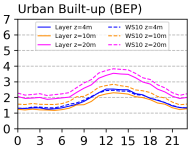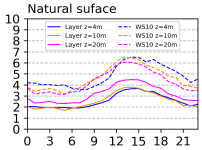Hi all, I've run WRF for three different cases by lowering the lowest model level height (z). So, the model height was set to 4 m, 10 m, and 20 m. The Figure below shows how the atmosphere was discretized in the first 500 m.

I know that WRF computes U10 and V10 in the Surface Layer parameterization, which in my case was Eta similarity together with Boulac PBL scheme.
However, when I looked at the wind speed magnitude calculated through U and V at the first layer of the model (blue) and the second layer of the model (red) and compared it with the wind speed of U10 and V10 variables, the results seemed a bit odd (as can be seen for each case above).



When the lowest model level height was set to z=20 m, the results were very similar between the wind speed at the second level (that varied approximately between 20-50 m) and wind speed interpolated at 10 m. On the other hand, when the lowest model level height was set to z=4 m, the interpolated wind speed was larger than the wind speed at levels 1 (4 m) and 2 (varied approximately between 4-10 m). So, I was wondering if there is a threshold regarding the lowest model level height when U10 and V10 are computed.
Another issue is if I want to compare my results with observations at 10 meters which approach should I follow? To use U10 and V10 to compute it or extract U and V from the layer corresponding to the 10 m, let's say in my example:
if z= 20m, I will extract U and V from the first layer.
if z= 10m, I will extract U and V from the first (0 - 10 m) or second layer (10 m- 24m) (??)
if z= 4m, I will extract U and V from the first (4 - 10 m) or second layer (10 m- 15 m) (??)
Thank you in advance.
Yasmin

I know that WRF computes U10 and V10 in the Surface Layer parameterization, which in my case was Eta similarity together with Boulac PBL scheme.
However, when I looked at the wind speed magnitude calculated through U and V at the first layer of the model (blue) and the second layer of the model (red) and compared it with the wind speed of U10 and V10 variables, the results seemed a bit odd (as can be seen for each case above).



When the lowest model level height was set to z=20 m, the results were very similar between the wind speed at the second level (that varied approximately between 20-50 m) and wind speed interpolated at 10 m. On the other hand, when the lowest model level height was set to z=4 m, the interpolated wind speed was larger than the wind speed at levels 1 (4 m) and 2 (varied approximately between 4-10 m). So, I was wondering if there is a threshold regarding the lowest model level height when U10 and V10 are computed.
Another issue is if I want to compare my results with observations at 10 meters which approach should I follow? To use U10 and V10 to compute it or extract U and V from the layer corresponding to the 10 m, let's say in my example:
if z= 20m, I will extract U and V from the first layer.
if z= 10m, I will extract U and V from the first (0 - 10 m) or second layer (10 m- 24m) (??)
if z= 4m, I will extract U and V from the first (4 - 10 m) or second layer (10 m- 15 m) (??)
Thank you in advance.
Yasmin


